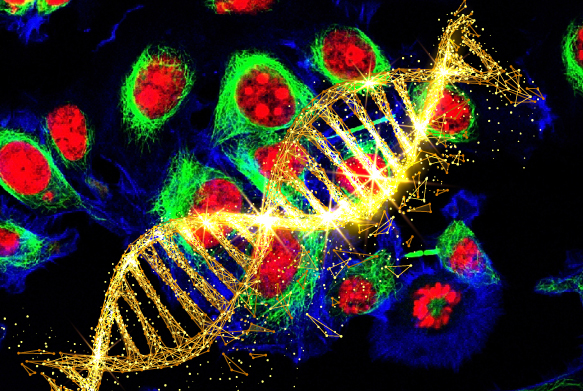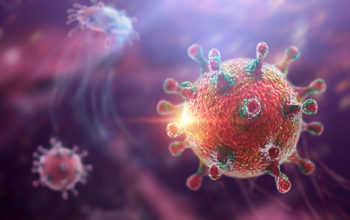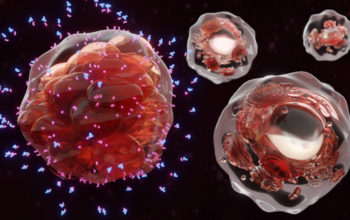
Date: 4th March 2022

With over 300 million people worldwide suffering with a genetic disorder and 95% lacking an FDA-approved treatment, the hunt for effective therapies is at the forefront of healthcare. One of the most promising gene replacement or editing techniques currently under intense scrutiny is CRISPR-Cas9 technology. Base editing and prime editing (PE) refine the use of the original Cas9 to a degree that may enable therapeutic applications. However, one challenge that has limited PE use is that some genomic sites are difficult to edit and the optimal design for PE tools, in particular the prime edit guide RNAs (pegRNAs), have yet to be elucidated. Now, researchers have designed a fluorescent prime editing and enrichment reporter (fluoPEER), which can be tailored to any genomic target site, the system can be used to screen optimal prime editing conditions, combining various pegRNA designs with prime editor variants.
In 2019, PE became the newest sensation in the gene editing field, emerging from David Liu’s lab at the Broad Institute of MIT and Harvard, US. It has been hailed as the ‘search-and-replace’ genome editing tool and is a precise technique that can generate any moderately sized genetic variation without the need for double-strand DNA breaks. The PE protein consists of a catalytically impaired Cas9 (nickase) tethered to an engineered reverse transcriptase (RT). This fusion protein forms a complex with a pegRNA which contains both a DNA-targeting and template repair domain. The technique allows repair of patient mutations, generation of disease models, and in vivo editing.
Now, researchers at University Medical Center Utrecht, The Netherlands, led by Sabine Fuchs have developed fluoPEER a quick and easy screening tool of pegRNA design for any PE variant in any genetic context, supporting PE research across the board. It utilises two fluorescent cassettes with a genomic target region in between which contains a stop codon or frameshift. The prime edit machinery targets and edits the genomic insert, removing the insertion or stop codon, leading to expression of both fluorescent reporters.
To start the team designed a fluoPEER plasmid. This entailed inserting the target region between an (e)GFP and an (m)Cherry cassette under constitutive expression. If the genomic target mutation resulted in a premature stop codon (nonsense) or a frameshift, the unmodified genomic target site was inserted into the fluoPEER plasmid – this resulted in a construct that only expressed GFP which indicated successful transfection. Effective prime editing of the fluoPEER plasmid resulted in the activation of Cherry expression, so successfully edited cells contained both reporters. If the genomic target mutation was not a nonsense or frameshift mutation, one was added to the target insert.
The team used the system to correct disease-causing mutations in patient-derived organoids such as cystic fibrosis and familial intrahepatic cholestasis (PFIC) type 3 and 1. It was an efficient method to optimise pegRNAs, test PAM preferences, explore different efficiencies of various PE proteins, and was even adaptable to test base editing gRNA design.
They also used FluorPEER to ask the question why certain cells were more prone to gene editing than others? They found that fluoPEER provided a transient selection method to enrich for genomic editing up to 3-fold compared to conventional selection of transfected cells. On closer analysis DNA repair and cell cycle-related genes were enriched in the transcriptome of the edited cells and the cells were stalled at the G1/S boundary. They could increase prime editing efficiency in cell lines by up to 30% by inducing the cells to artificially stall in this phase.
Conclusions and future applications
The team have developed fluoPEER as a customisable tool to guide pegRNA design, and to select and optimise prime editor proteins for almost any mutation in patient-derived cells. It also provides a transient selection method to enrich for genomic editing.
The data presented here suggests that the activity of DNA repair mechanisms, specifically homologous recombination, and the cell cycle may influence the outcome of prime editing, and is an important insight into PE efficiency.
The team envisage that their fluoPEER system will play a crucial role in accelerating and translating PE into the clinic to resolve genetic diseases in patients. PE is still a relatively new discovery but it is evolving at a fast rate however, it still requires extensive optimisation before it can be used in this manner. Tool such as these will be a valuable testbed and a welcome addition to gene editing technology, giving us a greater understanding of cellular processes underlying this genome editing technique, it will also help to establish disease-models and their repair.
Schene, I.F., Joore, I.P., Baijens, J.H.L., Stevelink, R., Kok, G., Shehata, S., Ilcken, E.F., Nieuwenhuis, E.C.M., Bolhuis, D.P., van Rees, R.C.M., et al. (2022). Mutation-specific reporter for optimization and enrichment of prime editing. Nature Communications 13, 1028.
https://doi.org/10.1038/s41467-022-28656-3
http://eha.3a7.mywebsitetransfer.com/pioneering-precise-genome-editing-method-genetic-diseases/


